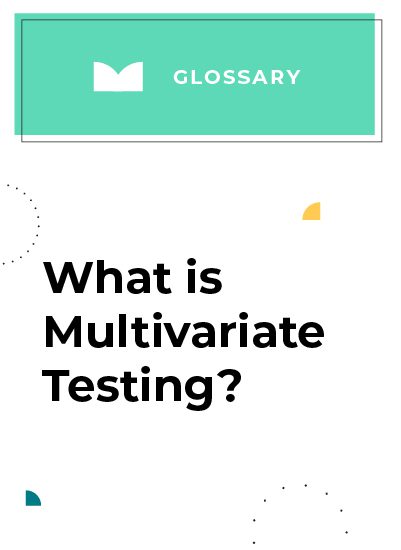
Multivariate Testing
What Is Multivariate Testing?
Multivariate testing is similar to A/B and A/B/n testing, yet enables testing multiple combinations on a single page at the same time.
You can think of a webpage as a collection of elements: images, buttons, text, etcetera.
In an A/B test, you can only test one element. For example, an “Add to Cart” button is an element on a webpage that can be changed. It could be altered to be green, orange, or red. Each separate color is a separate variant of that same element.
In a multivariate test (MVT), multiple variables are tested together at the same time in order to determine which combination produces the best outcome.
Designing a Multivariate Test
The two main ingredients of an MVT are elements and variants. Elements are the content or creative you want to test. Variants are the different versions of each element you are testing.
Because an MVT is used to find the single best combination of elements and variants, it has to explore and test all possible combinations. Calculating the number of combinations before running an MVT is a matter of simple math.
Here’s the simple multivariate testing equation.
[Number of variants of “A” element] X [Number of variants of “B” element] … = [Total number of combinations to be tested]
By way of example, if we were testing two elements, each with 2 variants, the total number of unique combinations would be 4.
Because of the math, adding new elements or variants to an MVT quickly increases the total combinations being tested on your webpage.
For instance, let’s assume you’ve chosen to MVT the following elements, and you want to know how many combinations you’ll have based on the number of variants you’re creating.
- Headline Content
- Hero Image
- Call to Action
If you’re testing 2 variants for each element, you will have 8 combinations of content (2 x 2 x 2 = 8).
If you’re testing 2 variants for “A” and “B” and have 3 variants for “C,” you will have 12 content combinations (2 x 2 x 3 = 12).
If you’re testing 3 variants of each element, you’ll have 27 content combinations (3 x 3 x 3 = 27).
Relatively simple MVT tests can produce many test combinations and can become complex quickly. So it’s worth finding an expert to carry it out.
Benefits of Multivariate Testing
In the marketing world, testing is a great way to understand your audiences better, learn how to cater to them, and optimize for your desired outcomes. Here are a few ways multivariate testing offers an advantage:
Behavioral Analysis
A multivariate test will allow you to study the preference patterns of customers, which means that you will have a better understanding of the page elements that contribute to the landing page’s objective.
Multiple Combinations
Multivariate testing allows you to simultaneously test multiple elements on a page to determine the most effective combination for the conversion goal. Because elements are tested in tandem, a multivariate test often has a more condensed testing period when compared to A/B testing.
Design Optimization
Every detail on the page matters, as well as the design as a whole.
Multivariate testing can be used to make incremental changes to the overall design of a page to achieve better results (greater engagement, increased conversions, etc.). It also helps identify elements that aren’t contributing to customer experience and conversions.

Complement A/B Testing
Multivariate testing software can be used to complement A/B testing efforts, especially in terms of refining the elements on the page for optimization.
For example, run an A/B test when undergoing a significant redesign to determine how it compares to the current version. Once the more effective design is found, use MVT to test multiple combinations of key elements.
Because of the number of content combinations, multivariate tests require a lot more traffic than A/B tests. Here’s a quick checklist to see if the page you want to test qualifies for an MVT:
- There is enough traffic on your test page to create conclusive results
- There is a defined goal for your test (e.g. lift in conversion rate)
- The content areas you want to test are readily visible to your visitors, and the content variations are different enough from each other to drive different behavior. (e.g. not just removing a comma in content)
- Your targeted audience for the MVT is large enough to allow the test to reach a high confidence level
If you can say “yes” to the checklist above, a multivariate test may offer the fastest way to improve your webpage user experience. Otherwise, a simple A/B test may be what you need to do the job.
